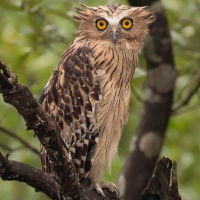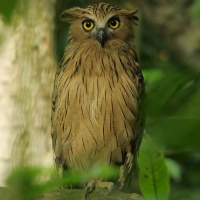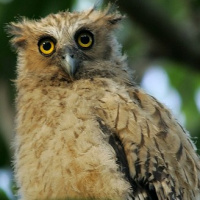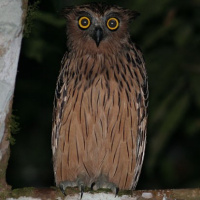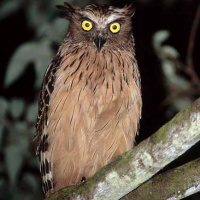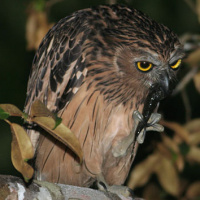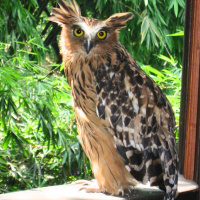Introduction
The Buffy Fish Owl is a medium to fairly large owl with prominent, outward-facing ear-tufts. It is also known as the Malay Fish Owl.
Photo Gallery (7 pictures)
Sound Gallery
Information
Description: Upperparts are rich brown, while the feathers of the back and mantle are blackish-brown, broadly margined with buff and with
pale rufous or whitish spots near the tips. The head and neck are the same as the upperparts but the feather tips don't have the spots. the forehead and
eyebrows are white, and the distinctive ear-tufts are sideward directed and very tousled. Eyes are yellow, with the eyelids rimmed black. The bill is black or
greyish-black.
Outer webs of scapulars are fulvous, but not forming a pale row across the shoulder. Wing coverts are the same as the back, but with much larger pale spots.
Primaries and secondaries are dark brown, banded with whitish or fulvous. The tail feathers are dark brown with whitish tips and 3 or 4 buffish-white bars.
Underparts are rufous-buff or fulvous with narrow dark brown shaft-streaks, these becoming narrower and sparser on the belly and undertail-coverts. Flanks and
thighs are unstreaked. Tarsi are relatively long and bare and are coloured yellowish-grey along with the toes. Claws are dark horn.
Size: Length 40-48cm. Wing length 295-390mm. Tail length 160-181mm. Weight 1028-2100g. Females are larger than males.
Habits: The Buffy Fish Owl shelters during the day, often singly, in dark places such as densely foliaged trees near nesting site.
Voice: A rattling kutook, kutook, kutook, kutook, kutook, kutook... is thought to be the song of the male. They are particularly noisy before breeding, and pairs participate in duetting which may continue for many minutes. The female has a slightly higher voice. Other vocalisations include a musical to-whee to-whee, a ringing pof-pof-pof...high hie-ee-ee-eek-keek notes and hissing sounds as well as.
Hunting & Food: As the name implies, a large proportion of the Buffy Fish Owl's diet consists of fish, as well as crustaceans, reptiles,
frogs, toads and insects. Rats, mice and large beetles are also taken. They will sometimes take bats, and reportedly feed on carrion.
Buffy Fish Owls fish from a perch an the water's edge, or from a tree on a wooded bank, swooping down to snatch prey from the water's surface. They will also
walk in shallow streams to snatch crabs, frogs, fish and aquatic insects.
Breeding: Eggs are found mainly in February to April, but less commonly in May to July (West Java) or in April and September to January
(Malay Peninsula). Often nests on tip of Bird's-nest ferns, or in the fork of a thick bough covered by ferns, moss and orchids. Buffy Fish Owls will also nest
in tree hollows or other raptors nests, and sometimes may resort to caves in rocky sites.
Usually one, but sometimes two eggs are laid, which are broadly oval and dull white, averaging 47.3-49 x 42.5-43.3 mm. Incubation of the eggs lasts 28-29 days.
Generally only one chick survives and will fledge after six weeks.
Mortality: Buffy Fish owls have lived for over 30 years in captivity. In regions with fish ponds, the Buffy Fish Owl is sometimes persecuted because of its fish-catching habits.
Habitat: Common in forested areas near water, often close to human habitations. Also found in mangrove forest and other coastal areas with woods and bushes. Found from sea level to 1600m.
Distribution: Buffy Fish Owls are found from far east India, through southern Bangladesh south through peninsular Thailand and Malay Peninsula, Sumatra, Java, Borneo and neighbouring islands. Also found in Laos, Vietnam, Cambodia, and southeastern parts of Thailand.
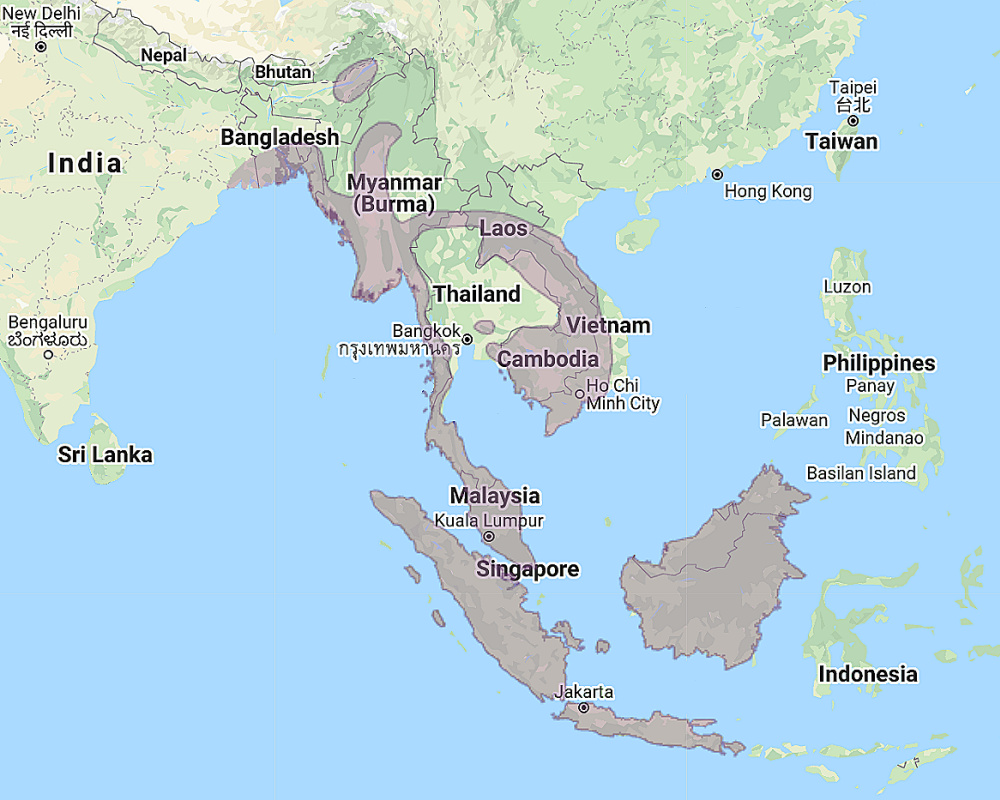
Range of the Buffy Fish Owl Ketupa ketupu
Status: Locally common.
Original Description: Horsfield, Thomas 1821. Transactions of the Linnean Society of London (Trans. Linn. Soc. London) (1) 13: p. 141.

